We are reader supported. When you purchase through links on our site, we may earn an affiliate commission. Also, as an Amazon affiliate, we earn from qualifying purchases.
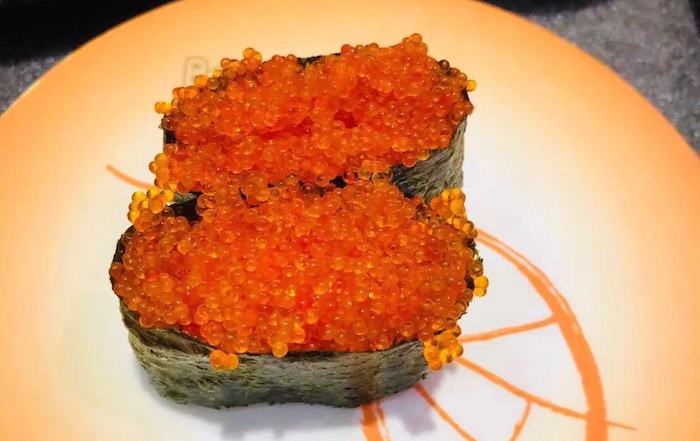
I had promised my niece to help her host a sushi party for friends and we chose her birthday to be that occasion. I wanted to make sushi look attractive and colorful for the kids, and I remembered that they serve fish eggs as toppings in sushi restaurants. The soft orange eggs look yummylicious!
I looked online to find out what are fish eggs on sushi called. Tobiko is the Japanese word for flying fish roe or fish eggs used in a variety of other traditional delicacies. The eggs are tiny, ranging from 0.5 to 0.8 mm. In their natural form, they have a red-orange color and crunchy texture.
The chefs often color tobiko to change their appearance and make them more visually appealing. For example, squid ink may be used to turn them black in color; yuzu can make tobiko look pale yellow and wasabi may be added to make fish eggs look green and spicy. If you wish to create a rainbow-like appearance, you may use a serving of tobiko containing an assortment of colors.
In some sushi restaurants, the chef may use masago (smelt roe or capelin) instead of tobiko because they look similar in appearance and the former costs less. However, an experienced diner who has a sharp eye for details can easily tell the difference between the two.
To prepare for the sushi party, we went to the nearest Asian grocery store to get some Tobiko and other essential ingredients to use in our recipe. I had shortlisted a few recipes that use fish eggs to try that evening and I would like to share them with you.
Contents
Yo Sushi Roll With Tobiko
After scouring the Internet for different sushi roll recipes that use tobiko, I found this one interesting and attractive looking. Here are the ingredients you will need:
• Cooked and seasoned sushi rice
• 1 avocado, pit removed and finely sliced
• Nori Seaweed
• Sashimi-grade salmon
• Orange tobiko (flying fish roe)
• Pickled ginger
• Wasabi
• Soy sauce
You can find my recommended ingredient on this page
Prepare sushi rice at least 30 minutes before you intend to start making sushi rolls to ensure that the rice is at room temperature. To find the perfect recipe for making sushi rice, click here
Cut the avocado into half using a sharp Japanese knife, remove the pit, peel outer cover and then make thin slices.
Take a piece of sashimi-grade salmon and use a sharp knife to slice the fish into 0.5 cm thick strips. The number of strips you need will depend on how many sushi rolls you wish to make. In this recipe, we use two salmon strips per roll.
Place a bamboo mat on the work area and cover it with a plastic sheet. Put a Nori sheet on the bamboo mat with the right side facing upwards.
Take a medium golf ball size sushi rice in your hand and spread it out on the Nori sheet, leaving half an inch space on all sides.
Flip the Nori sheet and add a little wasabi lengthwise on the middle section of the sheet. Add two salmon strips to cover the length of the sheet and two slices of avocado just beside the salmon strips.
Now, use the bamboo mat to lift the Nori sheet and make a tight and compact sushi roll. Press gently to ensure that the sushi rice sticks on the outside and does not fall off.
Cover the sushi roll with a generous spread of tobiko. Use the convex side of a spoon to evenly spread fish eggs throughout the roll.
I mixed 3-4 spoonfuls of tobiko with squid-ink and some more with yuzu to create different color toppings for that extra effect.
Once you are done layering the tobiko on the sushi roll, take the plastic sheet and cover the roll. Hug gently one more time to ensure that the eggs stick to the outer layer.
Moisten a sharp Japanese knife like this to cut equal sizes and serve with wasabi and soy sauce. To make the sushi roll look more delightful, serve them on elegant sushi dinnerware set.
Tobiko with Quail Egg Yolk
Ingredients
• 1 cup Japanese short grain rice
• Vinegar, salt and sugar for seasoning
• Nori sheet
• 4 fresh quail eggs
• 4 oz tobiko (flying fish roe)
You can find my recommended ingredient on this page
Cook sushi rice and season it with vinegar, salt, and sugar. Find the full recipe on how to cook sushi rice on cooker and pot here.
Take a full Nori sheet and slice it into four equal and thin strips lengthwise
Pick a ball of sushi rice and use your fingers to shape it as a nice oval bed, about 1.5 inches thick and 2.5 inches long.
Wrap the Nori slice around the sushi rice bed to make a boat shape. Seal the edges with a few grains.
Fill the open space over the rice bed with tobiko and put the inner contents of a raw quail egg on top of it. Some chefs prefer to use just the egg yolk while others use the whole egg.
Mini California Sushi Cones (With Tobiko)
Ingredients:
• 1 Cup of seasoned sushi rice
• Shiso leaves
• Japanese cucumber (seeded and julienned)
• 1/2 Avocado (cut sliced)
• 1 cup crab meat (shredded)
• Kewpie Mayo (to taste)
• 1 tablespoon tobiko (fish eggs)
• Toasted sesame seeds
• Wasabi
• Soy sauce
• Pickled ginger
You can find my recommended ingredient on this page
You will need cooked and seasoned sushi rice to begin this recipe, and you are lucky to be here as we have the recipe explained step-by-step for your convenience.
Cut the Nori sheets equally to get 6 small rectangular sheets. Put the shiny side down and apply 1-2 tablespoon of sushi rice to the left side of the Nori in a rough square.
Place a shiso leaf diagonally and top it with some crab shreds, a slice of avocado, and a few strips of cucumber. You may add some Kewpie Mayo to enhance the taste.
Fold the bottom left-hand corner of the Nori to create a cone shape. Seal the edges using some grains of rice.
Top up the cone with a generous spread of tobiko and toasted sesame seeds. Serve with wasabi, soy, and pickled ginger.
Now, that’s just a few recipes I think works best if you are hosting a kid’s party or even an adults’ sushi party at home. You can try and experiment with the different types of fish eggs available to know which one you like best and use them in your sushi recipes.
What Are The Different Types Of Fish Eggs
Tobiko (flying fish roe)
Tobiko is the familiar orange-colored fish eggs you see on sushi rolls served in the restaurants. This is perhaps the most recognized variety of fish eggs. They are small in size, ranging from 0.5 to 0.8 millimeters and their red-orange color looks vibrant and appealing.
Tobiko has a mild salty and smoky taste with a hint of sweetness and crunchy flavor that enhances the taste of anything they are added to. In sushi, they are used as toppings to improve the color and flavor. They are often mixed with squid ink, yuzu, or beet to change the colors for a more appetizing look.
Masago (smelt roe)
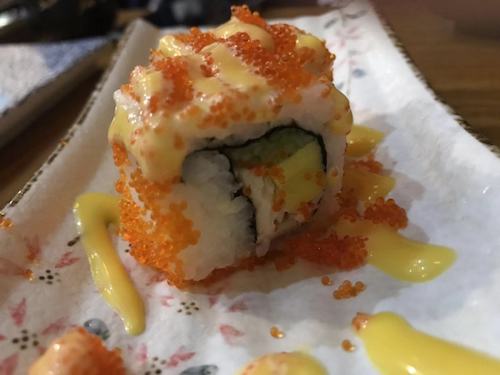
If you thought tobiko and masago were the same, you are not alone. They are strikingly similar and an untrained eye can hardly tell the difference. Masago is the Japanese name for eggs of capelin, a fish belonging to the smelt species.
Although both tobiko and masago have the same color, capelin eggs are visibly smaller and they do not feel as crunchy in the mouth. The taste is almost the same, with masago being slightly bitter at times. The sushi restaurants are known to pass masago as tobiko because the later is more expensive.
See Also: How long does Masago last?
Ikura (salmon roe)
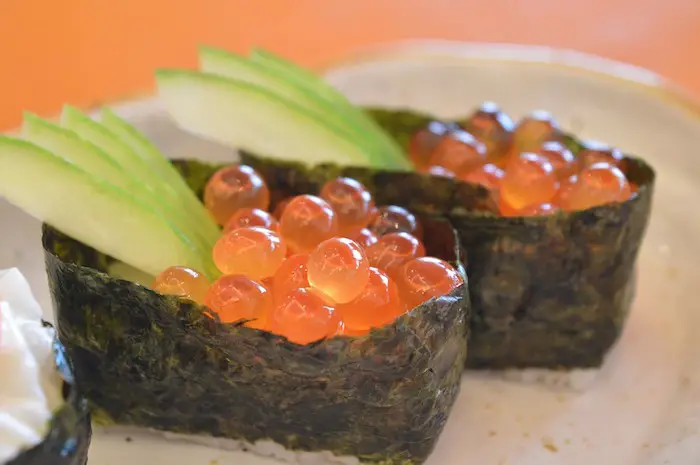
Ikura or salmon roe is visibly larger than tobiko and masago, and its appearance can be described as soft orange balls. The eggs are extremely delicate and gooey in texture. If you handle them with too much force, you will risk damaging them and spilling the bright and briny liquid inside.
Many upscale sushi restaurants use Ikura for decorative purposes. During the off-season, the chefs may receive frozen eggs from Alaska and they are then cured with salt to preserve them. In the month of May and June, fish eggs are easily available.
When Ikura is in season, you can see sushi restaurants in Japan serving fresh roe topped over a bed of sushi rice and wrapped in crunchy seaweed. These eggs may also be consumed in the sashimi style. Ikura is the most popular of these three types of roe and it is widely used in other non-Japanese cuisines.
Other Types Of Fish Eggs Used In Japanese Cuisine
The above three varieties (tobiko, masago, and Ikura) are most popularly used in sushi recipes. However, there are many other types of fish eggs that are often used on sushi and other Japanese dishes. Here are a few of them:
Tarako
This type of fish roe comes from the family of Alaska Pollock. Their sausage-like shape and unique taste make them stand apart. The eggs are usually salted to make them more palatable and they are not like other spicy versions. See more.
Sujiko

This is a type of salmon roe where the eggs are still located inside the sack. The eggs in this variety taste much sweeter than other types of fish eggs.
Kazunoko
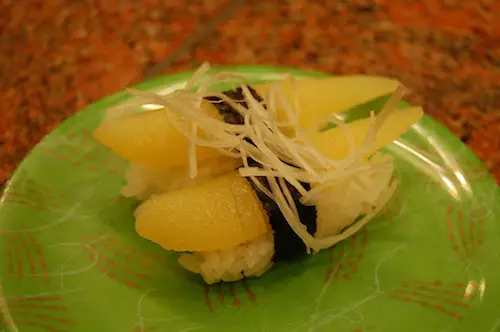
These are herring eggs and their color may change from pale flesh to a shade of yellow. Although this is not salmon roe, the eggs stick together in a mass like structure.
Paddlefish Caviar
This type of fish eggs is firm in texture and they sport a beautiful light grey color. They wear a bold appearance and taste salty like the sea. They are less expensive than other varieties.
Whitefish Caviar
These eggs come from the Whitefish or whitefish Caviar. They are known to have a tangy taste and unique flavor with a hint of sweetness that makes them extremely popular.
Bowfin Caviar
They are known to have a delicate tanginess and the eggs are small and brownish black. They may be used for decoration or as a delectable side dish.
Black Lumpfish Caviar
Also known as lumpfish roe, the Black Lumpfish Caviar is purified to add some shelf life to them. They are often praised for their crunchy texture.
Trout Caviar
The fish eggs come from freshwater trout that are found in the inland lakes in France. These eggs have a beautiful pink color with orange dots. They are known to have a rigid texture and a yummy flavor.
Tuna Bottarga
Often referred to as Boutargue or Botargo, these are tuna eggs that are dried and soaked in salt before consumption. They are known for their delicate flavors and are often used as a seasoning for delicacies.
Uni
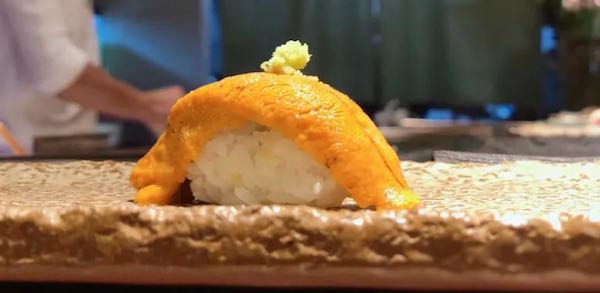
These are rare fish eggs that are harvested roe from the Sea Urchins. These eggs are significantly smaller in size than tobiko or
Mentaiko
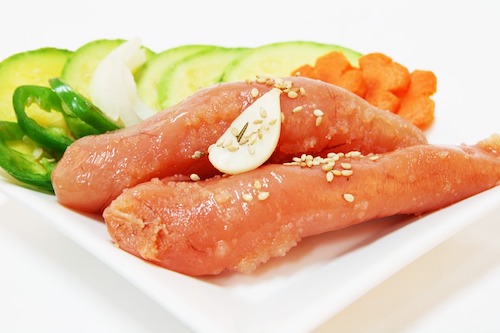
These fish eggs are extracted from the Alaska Pollock. The eggs are sprinkled with red chili powder and they come in different types of sacked structure. They are known to have an attractive pinkish-red color.
Related Questions
#1. Why are fish eggs known as roe?
Roe or hard roe refers to the completely ripe egg masses found in the female ovaries. They may often be the released egg masses of certain fish and marine animals like scallops, sea urchins, and shrimp. The fish roe may be used as a raw ingredient or cooked, as you prefer.
#2. What is the difference between caviar and fish roe?
Both fish roe and caviar refer to the same thing – fish eggs. While fish roe means fish eggs, caviar is the type of roe that has been cured and salted. They are kept in the tins for long-term storage and aging. In the US and Canada, any product that is labeled as caviar actually comes from sturgeon roe.
#3. What is the taste of salmon roe used on sushi?
If you eat raw salmon roe, you will get a salty and fishy taste in your mouth. It is known to have a gooey texture that melts inside the mouth. The masago or flying fish roe, on the other hand, is known to have a mildly sweet and savory flavor.
#4. Are the fish eggs on sushi real?
Yes, the orange balls you often see on sushi rolls or gunkan maki are for real. Tobiko are small-sized fish roe and they are slightly larger than masago or capelin roe. Natural tobiko has a bright red-orange color, however, the chef often colors them to make the dishes look more appealing.
#5. How do the fish eggs get different colors?
If the chef desires, he may use flying fish eggs to create a rainbow-like effect. Amazing quality of tobiko is that it can be infused with other natural ingredients such as yuzu, wasabi, beet, and squid ink to make the eggs look green, red, yellow, or black.

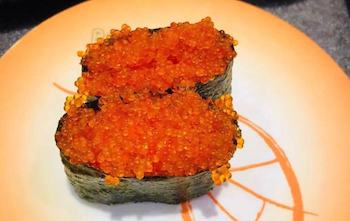
Comments
Pingback: Does Sushi Have Egg? - Easy Homemade Sushi
Pingback: What is Tobiko Sushi (Detailed Explanation) - Easy Homemade Sushi